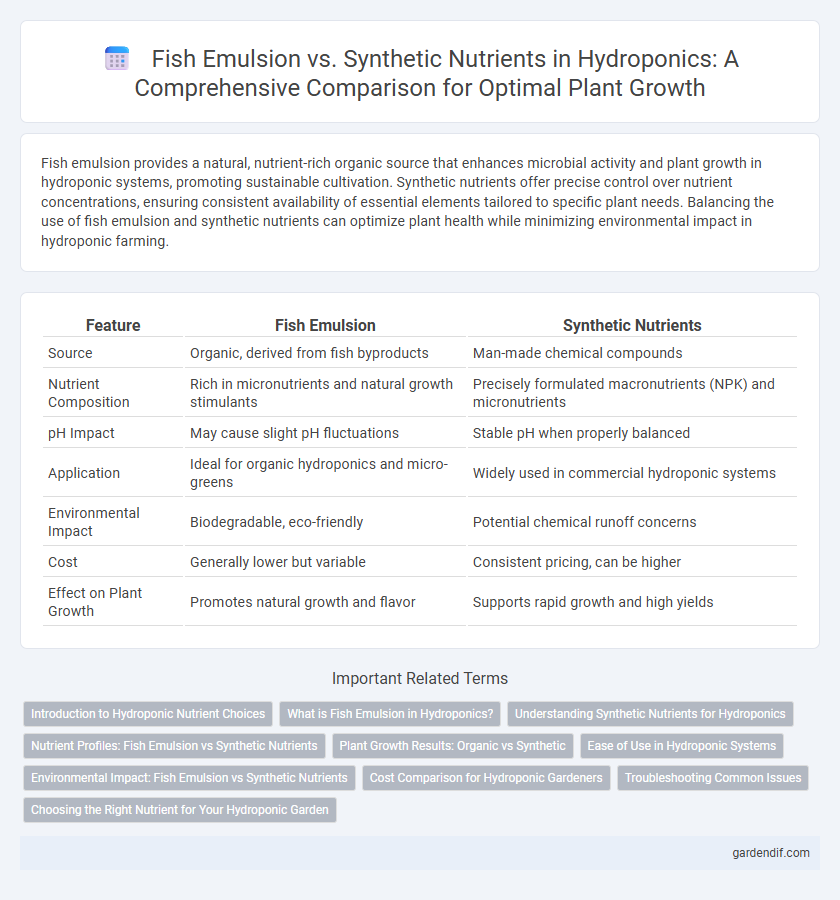
Fish Emulsion vs Synthetic Nutrients Illustration
Fish emulsion provides a natural, nutrient-rich organic source that enhances microbial activity and plant growth in hydroponic systems, promoting sustainable cultivation. Synthetic nutrients offer precise control over nutrient concentrations, ensuring consistent availability of essential elements tailored to specific plant needs. Balancing the use of fish emulsion and synthetic nutrients can optimize plant health while minimizing environmental impact in hydroponic farming.
Table of Comparison
| Feature | Fish Emulsion | Synthetic Nutrients |
|---|---|---|
| Source | Organic, derived from fish byproducts | Man-made chemical compounds |
| Nutrient Composition | Rich in micronutrients and natural growth stimulants | Precisely formulated macronutrients (NPK) and micronutrients |
| pH Impact | May cause slight pH fluctuations | Stable pH when properly balanced |
| Application | Ideal for organic hydroponics and micro-greens | Widely used in commercial hydroponic systems |
| Environmental Impact | Biodegradable, eco-friendly | Potential chemical runoff concerns |
| Cost | Generally lower but variable | Consistent pricing, can be higher |
| Effect on Plant Growth | Promotes natural growth and flavor | Supports rapid growth and high yields |
Introduction to Hydroponic Nutrient Choices
Fish emulsion and synthetic nutrients represent two primary hydroponic nutrient choices, each with distinct benefits for plant growth. Fish emulsion, derived from natural fish byproducts, provides organic macronutrients and micronutrients, promoting beneficial microbial activity in the root zone. Synthetic nutrients offer precise control over nutrient concentrations and faster availability, allowing growers to tailor fertilization regimes for optimal hydroponic crop yields.
What is Fish Emulsion in Hydroponics?
Fish emulsion in hydroponics is an organic liquid fertilizer derived from the byproducts of fish processing, rich in nitrogen, phosphorus, and potassium essential for plant growth. It supplies a balanced mix of macro and micronutrients that improve nutrient uptake and promote healthy root development in soilless systems. Unlike synthetic nutrients, fish emulsion enhances microbial activity in the nutrient solution, supporting a natural and sustainable hydroponic environment.
Understanding Synthetic Nutrients for Hydroponics
Synthetic nutrients for hydroponics are precisely formulated mineral solutions designed to provide essential macro and micronutrients directly to plants, enhancing growth rates and yield. These nutrient solutions typically contain nitrogen, phosphorus, potassium, calcium, magnesium, and trace elements in easily absorbable ionic forms, ensuring optimal nutrient availability in soilless environments. Their controlled composition allows growers to tailor nutrient profiles to specific crop requirements, promoting efficient nutrient uptake and consistent plant development in hydroponic systems.
Nutrient Profiles: Fish Emulsion vs Synthetic Nutrients
Fish emulsion provides a natural blend of macronutrients and micronutrients, including nitrogen, phosphorus, potassium, and trace elements essential for plant growth, along with beneficial amino acids and hormones that enhance root development. Synthetic nutrients offer precise and easily adjustable concentrations of essential minerals, enabling tailored nutrient delivery to meet specific crop requirements in hydroponic systems. Comparing nutrient profiles, fish emulsion tends to be richer in organic compounds and secondary metabolites, while synthetic nutrients ensure consistent, balanced ratios of primary nutrients for optimized plant uptake.
Plant Growth Results: Organic vs Synthetic
Fish emulsion provides a rich source of organic nitrogen, phosphorus, and potassium, enhancing microbial activity and improving nutrient availability, which promotes robust plant growth and improved root development in hydroponic systems. Synthetic nutrients deliver precise, immediately available macro- and micronutrients, resulting in faster growth rates and higher yields, but can lack the beneficial microbial stimulation found with organic inputs. Studies indicate plants grown with fish emulsion show improved leaf chlorophyll content and stress resilience, while those fed synthetic solutions typically achieve quicker maturation and consistent nutrient profiles.
Ease of Use in Hydroponic Systems
Fish emulsion offers a natural and organic nutrient solution that is easy to integrate into hydroponic systems, requiring minimal preparation and providing essential micronutrients. Synthetic nutrients often come in precise, pre-formulated mixes that simplify feeding schedules but demand careful monitoring of pH and EC levels to avoid nutrient imbalances. The ease of use in hydroponics depends on the grower's preference for organic inputs versus the controlled consistency of synthetic formulations.
Environmental Impact: Fish Emulsion vs Synthetic Nutrients
Fish emulsion, derived from natural fish byproducts, promotes environmental sustainability by recycling organic waste and reducing reliance on chemical production processes that emit greenhouse gases. Synthetic nutrients often involve energy-intensive manufacturing and contribute to water pollution through runoff containing harmful chemicals, posing risks to aquatic ecosystems. Utilizing fish emulsion in hydroponic systems supports eco-friendly nutrient cycling and minimizes chemical footprints compared to synthetic alternatives.
Cost Comparison for Hydroponic Gardeners
Fish emulsion typically costs more upfront than synthetic nutrients but offers organic benefits that can improve long-term soil and plant health in hydroponic systems. Synthetic nutrients provide a cost-effective, consistent, and easily adjustable nutrient supply, often preferred for budget-conscious hydroponic gardeners. Evaluating total expenses requires considering initial prices, frequency of application, and potential yield improvements linked to nutrient type.
Troubleshooting Common Issues
Fish emulsion often causes nutrient imbalances and odor issues in hydroponic systems, demanding regular monitoring of pH levels and filtration to prevent root damage and algae growth. Synthetic nutrients provide precise nutrient control, but can lead to salt buildup and chemical imbalances requiring periodic flushing and adjustment of electrical conductivity (EC) levels. Addressing common troubleshooting challenges involves maintaining optimal nutrient concentrations and tailoring solutions based on plant response and nutrient uptake rates.
Choosing the Right Nutrient for Your Hydroponic Garden
Fish emulsion offers organic nutrients rich in nitrogen, phosphorus, and trace minerals essential for plant growth, promoting healthier root development and microbial activity in hydroponic systems. Synthetic nutrients provide precise nutrient ratios with faster absorption rates, enabling tailored feeding schedules and consistent results in controlled environments. Selecting the right nutrient depends on your hydroponic garden's goals, budget, and preference for organic versus chemical inputs to optimize plant health and yield.
Fish Emulsion vs Synthetic Nutrients Infographic

 gardendif.com
gardendif.com